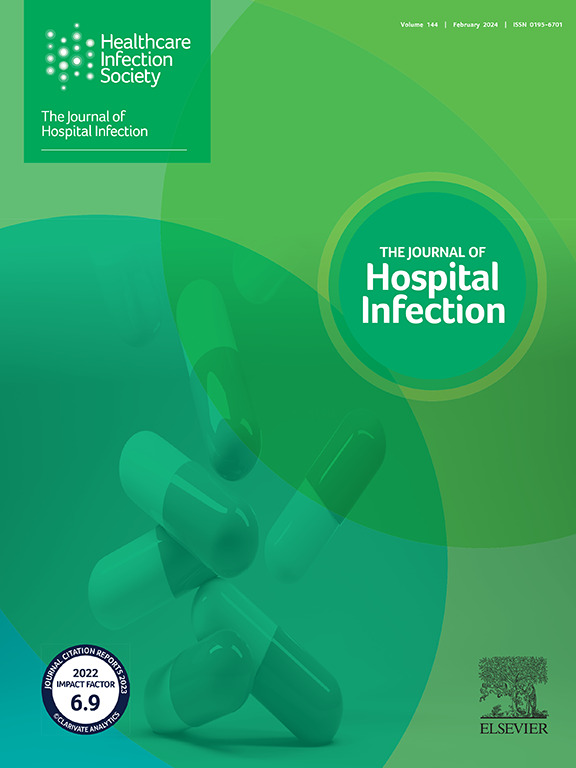碳青霉烯预授权的长期效果:一项超过20年的中断时间序列研究。
IF 3.1
3区 医学
Q1 INFECTIOUS DISEASES
引用次数: 0
摘要
背景:碳青霉烯类药物的预授权被认为可以有效减少碳青霉烯类药物的过度使用;然而,缺乏长期的评估。目的:我们评估了日本一家三级教学医院近二十年来明智限制碳青霉烯类药物的长期效果。方法:采用中断时间序列(ITS)分析,比较干预前(2004年和2005年)和干预期(2006年至2023年)碳青霉烯类抗菌药物使用密度(AUD)水平的变化及趋势。此外,本研究还探讨了住院患者碳青霉烯类药物AUD与医院获得性菌血症死亡率以及耐药院内病原菌引起的菌血症发生率之间的关系。结果:ITS分析显示,预授权后碳青霉烯类药物AUD水平变化显著降低(-0.367 / 100患者-天[95% CI, -0.131至-0.603;P = 0.002])。此外,趋势变化为-0.014 / 100患者日(95% CI, -0.001至-0.028;P = 0.048)。实施碳青霉烯预授权后,未观察到院内菌血症引起的28天死亡率增加。碳青霉烯烯AUD与耐甲氧西林金黄色葡萄球菌(相关系数[ρ] = 0.77 [p < 0.001])、铜绿假单胞菌(ρ = 0.85 [p < 0.001])、鲍曼不动杆菌(ρ = 0.80 [p < 0.001])的流行率呈显著正相关。结论:在一项20年的ITS分析中,长期实施碳青霉烯预授权一贯被证明是有效的,对医院流行病学没有不良后果。本文章由计算机程序翻译,如有差异,请以英文原文为准。
Long-term effect of carbapenem preauthorization: an interrupted time-series study over 20 years
Background
Preauthorization of carbapenems is considered effective in reducing carbapenem overuse; however, long-term evaluations are lacking.
Aim
We aimed to evaluate the long-term effects of judicious carbapenem restriction over almost two decades in a tertiary teaching hospital in Japan.
Methods
Interrupted time-series (ITS) analysis was applied to investigate changes in the level and trend of antimicrobial use density (AUD) of carbapenems by comparing the pre-intervention (2004 and 2005) and intervention (2006–2023) periods. Furthermore, this study explored the relationship between carbapenem AUD in hospitalized patients, the mortality rate of hospital-acquired bacteraemia, and the prevalence of bacteraemia caused by antibiotic-resistant nosocomial pathogens.
Findings
The ITS analysis demonstrated remarkably significant reductions in the level change of carbapenem AUD following the preauthorization (−0.367 per 100 patient days (95% confidence interval (CI), −0.131 to −0.603; P=0.002). In addition, the trend shift was −0.014 per 100 patient days (95% CI, −0.001 to −0.028; P=0.048). Following the implementation of carbapenem preauthorization, no increase in the 28-day mortality due to nosocomial bacteraemia was observed. Significant positive correlations were found between carbapenem AUD and the prevalence of meticillin-resistant Staphylococcus aureus (correlation coefficient (ρ) = 0.77 (P<0.001)), meropenem-resistant in Pseudomonas aeruginosa (ρ = 0.85 (P<0.001)), and Acinetobacter baumannii (ρ = 0.80 (P<0.001)).
Conclusions
Long-term implementation of carbapenem preauthorization consistently proved to be effective with no adverse consequences for hospital epidemiology in a 20-year ITS analysis.
求助全文
通过发布文献求助,成功后即可免费获取论文全文。
去求助
来源期刊

Journal of Hospital Infection
医学-传染病学
CiteScore
12.70
自引率
5.80%
发文量
271
审稿时长
19 days
期刊介绍:
The Journal of Hospital Infection is the editorially independent scientific publication of the Healthcare Infection Society. The aim of the Journal is to publish high quality research and information relating to infection prevention and control that is relevant to an international audience.
The Journal welcomes submissions that relate to all aspects of infection prevention and control in healthcare settings. This includes submissions that:
provide new insight into the epidemiology, surveillance, or prevention and control of healthcare-associated infections and antimicrobial resistance in healthcare settings;
provide new insight into cleaning, disinfection and decontamination;
provide new insight into the design of healthcare premises;
describe novel aspects of outbreaks of infection;
throw light on techniques for effective antimicrobial stewardship;
describe novel techniques (laboratory-based or point of care) for the detection of infection or antimicrobial resistance in the healthcare setting, particularly if these can be used to facilitate infection prevention and control;
improve understanding of the motivations of safe healthcare behaviour, or describe techniques for achieving behavioural and cultural change;
improve understanding of the use of IT systems in infection surveillance and prevention and control.
 求助内容:
求助内容: 应助结果提醒方式:
应助结果提醒方式:


